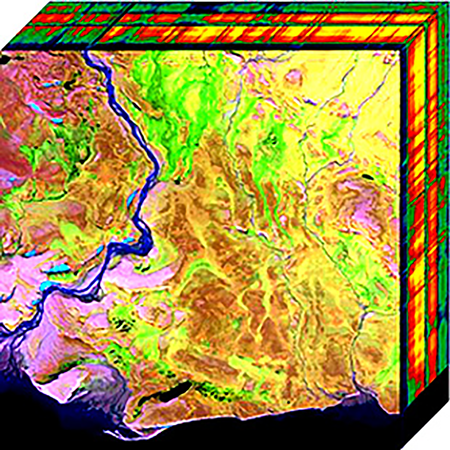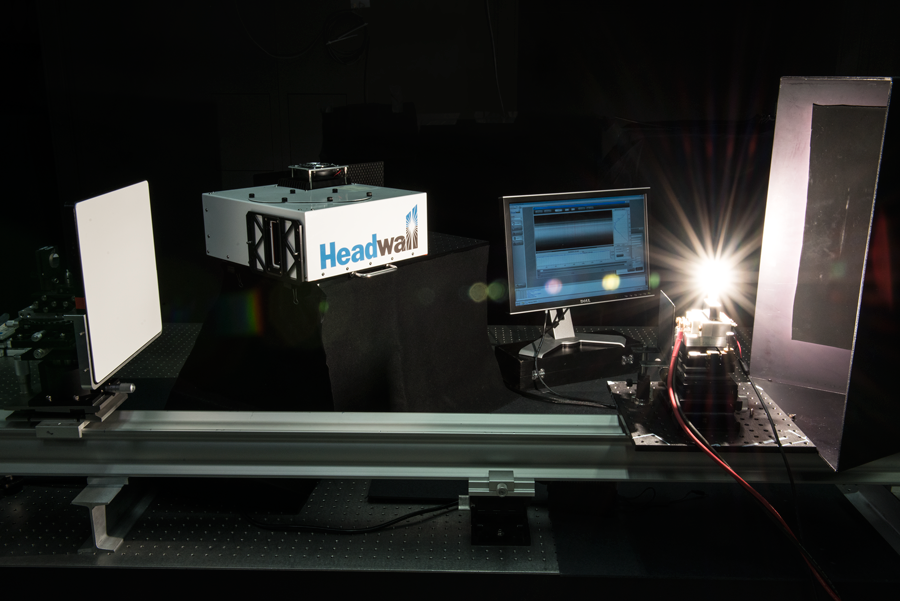
Hyperspectral imaging collects many individual images of a scene, each taken within a different narrow wavelength band. The result is a "data cube" of the combined images.
Hyperspectral images allow humans to see what otherwise might be invisible. Unlike ordinary cameras, which record information in each of three broad color bands – red, green, and blue – hyperspectral imagers provide a full spectrum for each pixel in an image, recording data in dozens or hundreds of different narrow wavelength bands. Some cover the full reflected solar range, from 350 nanometers (nm, billionths of a meter) in the near ultraviolet to 2500 nm in the short-wave infrared.
The resulting data, often gathered via unmanned aerial vehicles (UAVs), can reveal a host of properties such as environmental contaminants, the health of crops, and biomedical conditions that cannot be detected by the human eye but have distinctive telltale signals in hyperspectral images.
This technology has only recently come into broader use, but is already transforming a number of fields from food safety to surveillance, forensics, mineralogy, medicine, and experimental physics. The utility of the imagers, however, depends critically on their ability to discriminate and measure light at different wavelengths accurately. That's where NIST comes in.
"At present, there is no single established method for characterizing the range and performance of new hyperspectral instruments," says David Allen of NIST's Sensor Science Division (SSD). "Yet characterizing these imagers is critical in assessing how they perform in many applications."
NIST's Physical Measurement Laboratory (PML) already has the apparatus and expertise to thoroughly evaluate these sensors,* and research to identify optimal techniques is underway.
The facilities in the SSD have been used for decades to characterize space-borne satellite spectral imagers, such as those used to determine chlorophyll levels in sea water. These facilities, based on advanced radiometric sources traceable to the SI, are now beginning to be used to support the needs of smaller, compact, and increasingly available spectral imagers.
One hyperspectral imager that Allen and SSD colleagues B. Carol Johnson, John Woodward, and Howard Yoon have been characterizing (see photo at bottom of page) is used by ecologists to study the tropical rainforest in Costa Rica. In order to make observations above the forest canopy, the hyperspectral imager is flown on a UAV. Of the range of valuable information that can be derived from the spectra, the ecologists are particularly interested in a quantity referred to as "solar induced fluorescence" (SIF).
This quantity depends on the mechanisms of plant photosynthesis. When light is absorbed by a plant, only a portion of that light is used for photosynthesis. Some of the absorbed light is lost as heat and a small fraction, 1 % to 2 %, is reemitted as fluorescence at a longer wavelength. The fluorescence is correlated with the photosynthetic activity, and so provides a window into the biological condition of the plant.
"This phenomenon is well known in ocean observations," says Johnson, "where the increase in light in a narrow region of the spectrum at 683 nm is observable from the oceans because the incident sunlight is absorbed in that region by the seawater, resulting in low levels of reflected sunlight. The MODIS satellite fluorescence information is used to estimate phytoplankton concentration, chlorophyll fluorescence efficiency, and ultimately primary productivity."
For terrestrial vegetation, chlorophyll fluorescence is extremely valuable in observing plant growth rates, health, stress, and carbon assimilation, but the measurement itself is very challenging. The small fluorescence signal observed is dwarfed by the much larger signal from the inherent reflectance of the vegetation, resulting in a very large background signal.
This means that the hyperspectral imager must be well characterized in order to reliably measure SIF. That demand for precision radiometric characterization is why researchers such as plant ecologists are seeking the resources NIST has to offer. This work not only describes the performance of instruments such UAV-based hyperspectral imagers, but also provides the tools to improve measurements through the application of the NIST-based correction algorithms.
"The opportunity to get involved in this application of hyperspectral imaging has been particularly exciting," says SSD Division Chief Gerald Fraser, "not only because of the challenging measurement problem, but also because the physical measurement of light is used to derive a quantity of major biological and environmental importance, the primary productivity of plant life. What more can metrologists ask for in their work?"
NOTE: Any mention or depiction of commercial products within NIST web pages is for information only; it does not imply recommendation or endorsement by NIST.

* Wavelength calibration, assessment of stray light, linearity, and absolute responsivity can be done using the laser-based SIRCUS facility. Broadband sources, such as the lamp-illuminated diffuse reflectance standard shown here in PML's Remote Sensing Laboratory, can be used for integration time characterization, linearity, stability, and absolute responsivity. Novel spectral and spatial light engines such as the NIST Hyperspectral Image Projector can be used to present complex and real-life scenes that mimic the natural environment in terms of spatial, spectral, and temporal variability.

